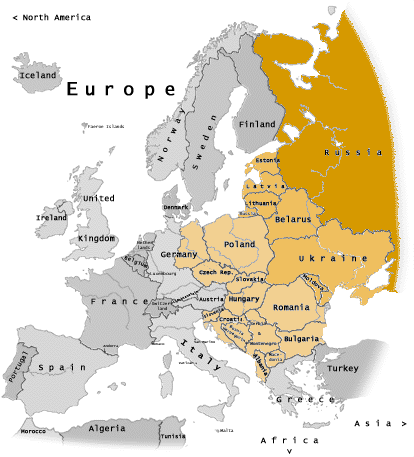Eastern Europe
|
|
Eastern Europe is, by convention, that part of Europe from the Ural and Caucasus mountains in the East to an arbitrarily chosen boundary in the West. Usually some or all of the countries adjacent to Russia's western border are included. As is also true of continents, regions are only social constructs and should not be understood as physical features defined by abstract, neutral criteria.
| Contents |
History
As a term, the origins of "Eastern Europe" are fairly recent. For many years Europe was divided on a North-South axis, with the southern Mediterranean states having much in common, and the northern Atlantic Ocean and Baltic Sea bordering states also having much in common (see also Northern Europe, Nordic Countries). The term "Eastern Europe" first arose in the 19th century, and was used to describe an area that was falling behind the rest of Europe economically. It was seen as a region where serfdom and reactionary autocratic governments persisted long after those things faded in the west. It was always a very vague notion, however, and many countries in the region did not fit the stereotypical view.
Much of Eastern Europe has ties to both the east and west. While all of the countries were heavily influenced by Roman Catholic or Protestant Christianity and have very close historical and cultural ties to Germany, Italy, France or Scandinavia (e.g. the Vikings in Russia, the Hanseatic league in the Baltics), many countries also had relations with the East. Russia was under the control of the Mongols for two centuries and inherited some political and social conventions from them. Further south the Ottoman Empire and Islam had a very strong influence. The nations of the Balkans as well as Hungary and Romania were all at one time controlled by the Turks.
The term is recently used in the Western countries to refer to all European countries that were previously under communist regimes, the so-called Eastern Bloc. The concept of Eastern Europe was greatly strengthened by the domination of the region by Communism and more specifically the Soviet Union after the Second World War. The idea of an "Iron Curtain" separating Eastern and Western Europe was dominant throughout the Cold War. This strict dualism causes problems, however, as it fails to account for complexities of the region. For instance, communist countries such as Yugoslavia and Albania refused to be controlled by the Kremlin, which however didn't make much difference to anti-Communists in the west.
Furthermore, a view that Europe is divided strictly into the West and the East is considered pejorative by the population of the nominally eastern countries, especially since the fall of the Berlin Wall and Communism in Europe overall. The Europeans from eastern countries do not classify themselves as "East Europeans" but prefer to include themselves in other groups, associating themselves with Central Europe, with Northern Europe, or with Southern Europe. People in the Baltic States and Poland may feel the label stigmatizing in comparison with countries that successfully have asserted their belonging to the West despite their Eastern location — and history as parts of Eastern Orthodoxy (Greece) or Imperial Russia (Finland).
Eastern Europe
The United Nations Statistics Division (http://unstats.un.org/unsd/methods/m49/m49regin.htm) defines Eastern Europe as:
These countries were all formerly within the Soviet Union:
Southeastern Europe/Balkan Peninsula
Commonly this definition is expanded to include these other previously communist countries:
Greece and the European part of Turkey are usually not included, as they are old NATO members.
Central Europe
The previously communist countries of Central Europe became included in the era of the Cold War:
- the Czech Republic - part of former Czechoslovakia
- Hungary
- Poland
- Slovakia - part of former Czechoslovakia
- Slovenia - formerly within Yugoslavia
- Croatia - formerly within Yugoslavia
Prior to the German reunification, East Germany was often counted to Eastern Europe.
See also
External link
- Civic Education Trends in Post-Communist Countries of Central and Eastern Europe (http://www.ericdigests.org/2004-2/europe.html)
| Regions of the world | |
| Africa: | Central Africa | Congo | East Africa | Great Lakes | Guinea | North Africa | Northwest Africa | Northeast Africa | Sahel | Southern Africa | Sub-Saharan Africa | Sudan | West Africa |
| Americas: | Andean States | Caribbean | Central America | Great Lakes | Great Plains | Guianas | Latin America | Southern Cone |
| Asia: | Central Asia | East Asia | East Indies | Far East | Indian subcontinent / South Asia | North Asia | Southeast Asia | Southwest Asia (Middle East, Levant, Anatolia, Arabia) |
| Europe: | Balkans | Baltic region | Benelux | British Isles | Central Europe | Eastern Europe | Northern Europe | Scandinavia | Southern Europe | Western Europe |
| Other: | Eurasia: Caucasus | Post-Soviet states | Oceania: Australasia | Melanesia | Micronesia | Polynesia | Aleutia | Pacific Rim | Polar: Arctic | Antarctic |
cv:Хěвелтухăç енчи Европа da:Østeuropa de:Osteuropa fr:Europe de l'Est id:Eropa Timur he:מזרח אירופה lt:Rytų Europa nl:Oost-Europa ja:東ヨーロッパ pl:Europa Wschodnia ro:Europa de Est ru:Восточная Европа sv:Östeuropa zh:东欧

